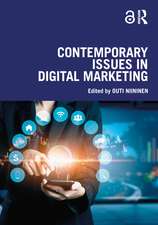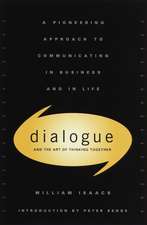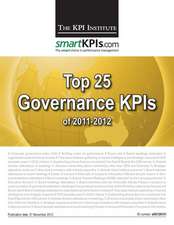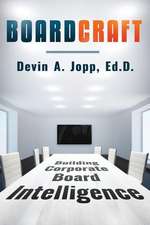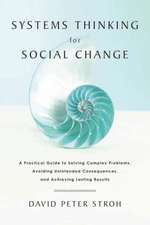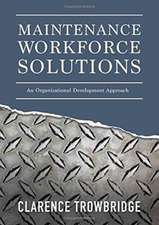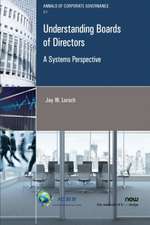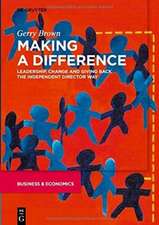The Fifth Discipline: The Art & Practice of the Learning Organization
Autor Peter Sengeen Limba Engleză Paperback – 28 feb 2006
This revised edition of Peter Senge’s bestselling classic, The Fifth Discipline, is based on fifteen years of experience in putting the book’s ideas into practice. As Senge makes clear, in the long run the only sustainable competitive advantage is your organization’s ability to learn faster than the competition. The leadership stories in the book demonstrate the many ways that the core ideas in The Fifth Discipline, many of which seemed radical when first published in 1990, have become deeply integrated into people’s ways of seeing the world and their managerial practices.
In The Fifth Discipline, Senge describes how companies can rid themselves of the learning “disabilities” that threaten their productivity and success by adopting the strategies of learning organizations—ones in which new and expansive patterns of thinking are nurtured, collective aspiration is set free, and people are continually learning how to create results they truly desire.
The updated and revised Currency edition of this business classic contains over one hundred pages of new material based on interviews with dozens of practitioners at companies like BP, Unilever, Intel, Ford, HP, Saudi Aramco, and organizations like Roca, Oxfam, and The World Bank. It features a new Foreword about the success Peter Senge has achieved with learning organizations since the book’s inception, as well as new chapters on Impetus (getting started), Strategies, Leaders’ New Work, Systems Citizens, and Frontiers for the Future.
Mastering the disciplines Senge outlines in the book will:
• Reignite the spark of genuine learning driven by people focused on what truly matters to them
• Bridge teamwork into macro-creativity
• Free you of confining assumptions and mindsets
• Teach you to see the forest and the trees
• End the struggle between work and personal time
Preț: 178.17 lei
Nou
Puncte Express: 267
Preț estimativ în valută:
34.09€ • 35.67$ • 28.32£
34.09€ • 35.67$ • 28.32£
Carte disponibilă
Livrare economică 12-26 martie
Preluare comenzi: 021 569.72.76
Specificații
ISBN-13: 9780385517256
ISBN-10: 0385517254
Pagini: 445
Dimensiuni: 161 x 231 x 27 mm
Greutate: 0.54 kg
Editura: Broadway Business
ISBN-10: 0385517254
Pagini: 445
Dimensiuni: 161 x 231 x 27 mm
Greutate: 0.54 kg
Editura: Broadway Business
Extras
1
Give Me a Lever Long Enough… And Single-Handed I Can Move The World
From a very early age, we are taught to break apart problems, to fragment the world. This apparently makes complex tasks and subjects more manageable, but we pay a hidden, enormous price. We can no longer see the consequences of our actions; we lose our intrinsic sense of connection to a larger whole. When we then try to “see the big picture,” we try to reassemble the fragments in our minds, to list and organize all the pieces. But, as physicist David Bohm says, the task is futile–similar to trying to reassemble the fragments of a broken mirror to see a true reflection. Thus, after a while we give up trying to see the whole altogether.
The tools and ideas presented in this book are for destroying the illusion that the world is created of separate, unrelated forces. When we give up this illusion–we can then build “learning organizations,” organizations where people continually expand their capacity to create the results they truly desire, where new and expansive patterns of thinking are nurtured, where collective aspiration is set free, and where people are continually learning how to learn together.
As the world becomes more interconnected and business becomes more complex and dynamic, work must become more “learningful.” It is no longer sufficient to have one person learning for the organization, a Ford or a Sloan or a Watson or a Gates. It’s just not possible any longer to figure it out from the top, and have everyone else following the orders of the “grand strategist.” The organizations that will truly excel in the future will be the organizations that discover how to tap people’s commitment and capacity to learn at all levels in an organization.
Learning organizations are possible because, deep down, we are all learners. No one has to teach an infant to learn. In fact, no one has to teach infants anything. They are intrinsically inquisitive, masterful learners who learn to walk, speak, and pretty much run their households all on their own. Learning organizations are possible because not only is it our nature to learn but we love to learn. Most of us at one time or another have been part of a great team, a group of people who functioned together in an extraordinary way– who trusted one another, who complemented one anothers’s strengths and compensated for one another’s limitations, who had common goals that were larger than individual goals, and who produced extraordinary results. I have met many people who have experienced this sort of profound teamwork–in sports, or in the performing arts, or in business. Many say that they have spent much of their life looking for that experience again. What they experienced was a learning organization. The team that became great didn’t start off great–it learned how to produce extraordinary results.
One could argue that the entire global business community is learning to learn together, becoming a learning community. Whereas once many industries were dominated by a single, undisputed leader–one IBM, one Kodak, one Xerox–today industries, especially in manufacturing, have dozens of excellent companies. American, European, or Japanese corporations are pulled forward by innovators in China, Malaysia, or Brazil, and they in turn, are pulled by the Koreans and Indians. Dramatic improvements take place in corporations in Italy, Australia, Singapore–and quickly become influential around the world.
There is also another, in some ways deeper, movement toward learning organizations, part of the evolution of industrial society. Material affluence for the majority has gradually shifted people’s orientation toward work–from what Daniel Yankelovich called an “instrumental” view of work, where work was a means to an end, to a more “sacred” view, where people seek the “intrinsic” benefits of work.(1) “Our grandfathers worked six days a week to earn what most of us now earn by Tuesday afternoon,” says Bill O’Brien, former CEO of Hanover Insurance. “The ferment in management will continue until we build organizations that are more consistent with man’s higher aspirations beyond food, shelter and belonging.”
Moreover, many who share these values are now in leadership positions. I find a growing number of organizational leaders who, while still a minority, feel they are part of a profound evolution in the nature of work as a social institution. “Why can’t we do good works at work?” asked Edward Simon, former president of Herman Miller, a sentiment I often hear repeated today. In founding the “Global Compact,” UN Secretary General Kofi Annan invited businesses around the world to build learning communities that elevate global standards for labor rights, and social and environmental responsibility.
Perhaps the most salient reason for building learning organizations is that we are only now starting to understand the capabilities such organizations must possess. For a long time, efforts to build learning organizations were like groping in the dark until the skills, areas of knowledge, and paths for development of such organizations became known. What fundamentally will distinguish learning organizations from traditional authoritarian “controlling organizations” will be the mastery of certain basic disciplines. That is why the “disciplines of the learning organization” are vital.
DISCIPLINES OF THE LEARNING ORGANIZA TION
On a cold, clear morning in December 1903, at Kitty Hawk, North Carolina, the fragile aircraft of Wilbur and Orville Wright proved that powered flight was possible. Thus was the airplane invented; but it would take more than thirty years before commercial aviation could serve the general public.
Engineers say that a new idea has been “invented” when it is proven to work in the laboratory. The idea becomes an “innovation” only when it can be replicated reliably on a meaningful scale at practical costs. If the idea is sufficiently important, such as the telephone, the digital computer, or commercial aircraft, it is called a “basic innovation,” and it creates a new industry or transforms an existing industry. In these terms, learning organizations have been invented, but they have not yet been innovated.
In engineering, when an idea moves from an invention to an innovation, diverse “component technologies” come together. Emerging from isolated developments in separate fields of research, these components gradually form an ensemble of technologies that are critical to one another’s success. Until this ensemble forms, the idea, though possible in the laboratory, does not achieve its potential in practice.(2)
The Wright brothers proved that powered flight was possible, but the McDonnel Douglas DC3, introduced in 1935, ushered in the era of commercial air travel. The DC3 was the first plane that supported itself economically as well as aerodynamically. During those intervening thirty years (a typical time period for incubating basic innovations), myriad experiments with commercial flight had failed. Like early experiments with learning organizations, the early planes were not reliable and cost-effective on an appropriate scale.
The DC-3, for the first time, brought together five critical component technologies that formed a successful ensemble. They were: the variable-pitch propeller, retractable landing gear, a type of lightweight molded body construction called “monocque,” a radial air-cooled engine, and wing flaps. To succeed, the DC3 needed all five; four were not enough. One year earlier, the Boeing 247 was introduced with all of them except wing flaps. Boeing’s engineers found that the plane, lacking wing flaps, was unstable on takeoff and landing, and they had to downsize the engine.
Today, I believe, five new component technologies are gradually converging to innovate learning organizations. Though developed separately, each will, I believe, prove critical to the others’ success, just as occurs with any ensemble. Each provides a vital dimension in building organizations that can truly “learn,” that can continually enhance their capacity to realize their highest aspirations:
Systems Thinking. A cloud masses, the sky darkens, leaves twist upward, and we know that it will rain. We also know the storm runoff will feed into groundwater miles away, and the sky will clear by tomorrow. All these events are distant in time and space, and yet they are all connected within the same pattern. Each has an influence on the rest, an influence that is usually hidden from view. You can only understand the system of a rainstorm by contemplating the whole, not any individual part of the pattern.
Business and other human endeavors are also systems. They, too, are bound by invisible fabrics of interrelated actions, which often take years to fully play out their effects on each other. Since we are part of that lacework ourselves, it’s doubly hard to see the whole pattern of change. Instead, we tend to focus on snapshots of isolated parts of the system, and wonder why our deepest problems never seem to get solved. Systems thinking is a conceptual framework, a body of knowledge and tools that has been developed over the past fifty years, to make the full patterns clearer, and to help us see how to change them effectively.
Though the tools are new, the underlying worldview is extremely intuitive; experiments with young children show that they learn systems thinking very quickly.
Personal Mastery. “Mastery” might suggest gaining dominance over people or things. But mastery can also mean a special level of proficiency. A master craftsman doesn’t dominate pottery or weaving. People with a high level of personal mastery are able to consistently realize the results that matter most deeply to them– in effect, they approach their life as an artist would approach a work of art. They do that by becoming committed to their own lifelong learning.
Personal mastery is the discipline of continually clarifying and deepening our personal vision, of focusing our energies, of developing patience, and of seeing reality objectively. As such, it is an essential cornerstone of the learning organization–the learning organization’s spiritual foundation. An organization’s commitment to and capacity for learning can be no greater than that of its members. The roots of this discipline lie in both Eastern and Western spiritual traditions, and in secular traditions as well.
Bu few organizations encourage the growth of their people in this manner. This results in vast untapped resources: “People enter business as bright, well-educated, high-energy people, full of energy and desire to make a difference,” says Hanover’s O’Brien. “By the time they are 30, a few are on the fast track and the rest ‘put in their time’ to do what matters to them on the weekend. They lose the commitment, the sense of mission, and the excitement with which they started their careers. We get damn little of their energy and almost none of their spirit.”
And surprisingly few adults work to rigorously develop their own personal mastery. When you ask most adults what they want from their lives, they often talk first about what they’d like to get rid of: “I’d like my mother-in-law to move out,” they say, or “I’d like my back problems to clear up.” The discipline of personal mastery starts with clarifying the things that really matter to us, of living our lives in the service of our highest aspirations.
Here, I am most interested in the connections between personal learning and organizational learning, in the reciprocal commitments between individual and organization, and in the special spirit of an enterprise made up of learners.
Mental Models. Mental models are deeply ingrained assumptions, generalizations, or even pictures or images that influence how we understand the world and how we take action. Very often, we are not consciously aware of our mental models or the effects they have on our behavior. For example, we may notice that a coworker dresses elegantly, and say to ourselves, “She’s a country club person.” About someone who dresses shabbily, we may feel, “He doesn’t care about what others think.” Mental models of what can or cannot be done in different management settings are no less deeply entrenched. Many insights into new markets or outmoded organizational practices fail to get put into practice because they conflict with powerful, tacit mental models.
For example, in the early 1970s, Royal Dutch/Shell, became one of the first large organizations to understand how pervasive was the influence of hidden mental models. Shell’s success in the 1970s and 1980s (rising from one of the weakest of the big seven oil companies to one of the strongest along with Exxon) during a period of unprecedented changes in the world oil business–the formation of OPEC, extreme fluctuations in oil prices and availability, and the eventual collapse of the Soviet Union–came in large measure from learning how to surface and challenge managers’ mental models as a discipline for preparing change. Arie de Geus, Shell’s Coordinator of Group Planning during the 80s, said that continuous adaptation and growth in a changing business environment depends on “institutional learning, which is the process whereby management teams change their shared mental models of the company, their markets, and their competitors. For this reason, we think of planning as learning and of corporate planning as institutional learning.”(3)
The discipline of working with mental models starts with turning the mirror inward; learning to unearth our internal pictures of the world, to bring them to the surface and hold them rigorously to scrutiny. It also includes the ability to carry on “learningful” conversations that balance inquiry and advocacy, where people expose their own thinking effectively and make that thinking open to the influence of others.
Building Shared Vision. If any one idea about leadership has inspired organizations for thousands of years, it’s the capacity to hold a shared picture of the future we seek to create. One is hardpressed to think of any organization that has sustained some measure of greatness in the absence of goals, values, and missions that become deeply shared throughout the organization. IBM had “service”; Polaroid had instant photography; Ford had public transportation for the masses and Apple had “computers for the rest of us.”(4) Though radically different in content and kind, all these organizations managed to bind people together around a common identity and sense of destiny.
When there is a genuine vision (as opposed to the all-too-familiar “vision statement”), people excel and learn, not because they are told to, but because they want to. But many leaders have personal visions that never get translated into shared visions that galvanize an organization. All too often, a company’s shared vision has revolved around the charisma of a leader, or around a crisis that galvanizes everyone temporarily. But, given a choice, most people opt for pursuing a lofty goal, not only in times of crisis but at all times. What has been lacking is a discipline for translating individual vision into shared vision–not a “cookbook” but a set of principles and guiding practices.
The practice of shared vision involves the skills of unearthing shared “pictures of the future” that foster genuine commitment and enrollment rather than compliance. In mastering this discipline, leaders learn the counter-productiveness of trying to dictate a vision, no matter how heartfelt.
Give Me a Lever Long Enough… And Single-Handed I Can Move The World
From a very early age, we are taught to break apart problems, to fragment the world. This apparently makes complex tasks and subjects more manageable, but we pay a hidden, enormous price. We can no longer see the consequences of our actions; we lose our intrinsic sense of connection to a larger whole. When we then try to “see the big picture,” we try to reassemble the fragments in our minds, to list and organize all the pieces. But, as physicist David Bohm says, the task is futile–similar to trying to reassemble the fragments of a broken mirror to see a true reflection. Thus, after a while we give up trying to see the whole altogether.
The tools and ideas presented in this book are for destroying the illusion that the world is created of separate, unrelated forces. When we give up this illusion–we can then build “learning organizations,” organizations where people continually expand their capacity to create the results they truly desire, where new and expansive patterns of thinking are nurtured, where collective aspiration is set free, and where people are continually learning how to learn together.
As the world becomes more interconnected and business becomes more complex and dynamic, work must become more “learningful.” It is no longer sufficient to have one person learning for the organization, a Ford or a Sloan or a Watson or a Gates. It’s just not possible any longer to figure it out from the top, and have everyone else following the orders of the “grand strategist.” The organizations that will truly excel in the future will be the organizations that discover how to tap people’s commitment and capacity to learn at all levels in an organization.
Learning organizations are possible because, deep down, we are all learners. No one has to teach an infant to learn. In fact, no one has to teach infants anything. They are intrinsically inquisitive, masterful learners who learn to walk, speak, and pretty much run their households all on their own. Learning organizations are possible because not only is it our nature to learn but we love to learn. Most of us at one time or another have been part of a great team, a group of people who functioned together in an extraordinary way– who trusted one another, who complemented one anothers’s strengths and compensated for one another’s limitations, who had common goals that were larger than individual goals, and who produced extraordinary results. I have met many people who have experienced this sort of profound teamwork–in sports, or in the performing arts, or in business. Many say that they have spent much of their life looking for that experience again. What they experienced was a learning organization. The team that became great didn’t start off great–it learned how to produce extraordinary results.
One could argue that the entire global business community is learning to learn together, becoming a learning community. Whereas once many industries were dominated by a single, undisputed leader–one IBM, one Kodak, one Xerox–today industries, especially in manufacturing, have dozens of excellent companies. American, European, or Japanese corporations are pulled forward by innovators in China, Malaysia, or Brazil, and they in turn, are pulled by the Koreans and Indians. Dramatic improvements take place in corporations in Italy, Australia, Singapore–and quickly become influential around the world.
There is also another, in some ways deeper, movement toward learning organizations, part of the evolution of industrial society. Material affluence for the majority has gradually shifted people’s orientation toward work–from what Daniel Yankelovich called an “instrumental” view of work, where work was a means to an end, to a more “sacred” view, where people seek the “intrinsic” benefits of work.(1) “Our grandfathers worked six days a week to earn what most of us now earn by Tuesday afternoon,” says Bill O’Brien, former CEO of Hanover Insurance. “The ferment in management will continue until we build organizations that are more consistent with man’s higher aspirations beyond food, shelter and belonging.”
Moreover, many who share these values are now in leadership positions. I find a growing number of organizational leaders who, while still a minority, feel they are part of a profound evolution in the nature of work as a social institution. “Why can’t we do good works at work?” asked Edward Simon, former president of Herman Miller, a sentiment I often hear repeated today. In founding the “Global Compact,” UN Secretary General Kofi Annan invited businesses around the world to build learning communities that elevate global standards for labor rights, and social and environmental responsibility.
Perhaps the most salient reason for building learning organizations is that we are only now starting to understand the capabilities such organizations must possess. For a long time, efforts to build learning organizations were like groping in the dark until the skills, areas of knowledge, and paths for development of such organizations became known. What fundamentally will distinguish learning organizations from traditional authoritarian “controlling organizations” will be the mastery of certain basic disciplines. That is why the “disciplines of the learning organization” are vital.
DISCIPLINES OF THE LEARNING ORGANIZA TION
On a cold, clear morning in December 1903, at Kitty Hawk, North Carolina, the fragile aircraft of Wilbur and Orville Wright proved that powered flight was possible. Thus was the airplane invented; but it would take more than thirty years before commercial aviation could serve the general public.
Engineers say that a new idea has been “invented” when it is proven to work in the laboratory. The idea becomes an “innovation” only when it can be replicated reliably on a meaningful scale at practical costs. If the idea is sufficiently important, such as the telephone, the digital computer, or commercial aircraft, it is called a “basic innovation,” and it creates a new industry or transforms an existing industry. In these terms, learning organizations have been invented, but they have not yet been innovated.
In engineering, when an idea moves from an invention to an innovation, diverse “component technologies” come together. Emerging from isolated developments in separate fields of research, these components gradually form an ensemble of technologies that are critical to one another’s success. Until this ensemble forms, the idea, though possible in the laboratory, does not achieve its potential in practice.(2)
The Wright brothers proved that powered flight was possible, but the McDonnel Douglas DC3, introduced in 1935, ushered in the era of commercial air travel. The DC3 was the first plane that supported itself economically as well as aerodynamically. During those intervening thirty years (a typical time period for incubating basic innovations), myriad experiments with commercial flight had failed. Like early experiments with learning organizations, the early planes were not reliable and cost-effective on an appropriate scale.
The DC-3, for the first time, brought together five critical component technologies that formed a successful ensemble. They were: the variable-pitch propeller, retractable landing gear, a type of lightweight molded body construction called “monocque,” a radial air-cooled engine, and wing flaps. To succeed, the DC3 needed all five; four were not enough. One year earlier, the Boeing 247 was introduced with all of them except wing flaps. Boeing’s engineers found that the plane, lacking wing flaps, was unstable on takeoff and landing, and they had to downsize the engine.
Today, I believe, five new component technologies are gradually converging to innovate learning organizations. Though developed separately, each will, I believe, prove critical to the others’ success, just as occurs with any ensemble. Each provides a vital dimension in building organizations that can truly “learn,” that can continually enhance their capacity to realize their highest aspirations:
Systems Thinking. A cloud masses, the sky darkens, leaves twist upward, and we know that it will rain. We also know the storm runoff will feed into groundwater miles away, and the sky will clear by tomorrow. All these events are distant in time and space, and yet they are all connected within the same pattern. Each has an influence on the rest, an influence that is usually hidden from view. You can only understand the system of a rainstorm by contemplating the whole, not any individual part of the pattern.
Business and other human endeavors are also systems. They, too, are bound by invisible fabrics of interrelated actions, which often take years to fully play out their effects on each other. Since we are part of that lacework ourselves, it’s doubly hard to see the whole pattern of change. Instead, we tend to focus on snapshots of isolated parts of the system, and wonder why our deepest problems never seem to get solved. Systems thinking is a conceptual framework, a body of knowledge and tools that has been developed over the past fifty years, to make the full patterns clearer, and to help us see how to change them effectively.
Though the tools are new, the underlying worldview is extremely intuitive; experiments with young children show that they learn systems thinking very quickly.
Personal Mastery. “Mastery” might suggest gaining dominance over people or things. But mastery can also mean a special level of proficiency. A master craftsman doesn’t dominate pottery or weaving. People with a high level of personal mastery are able to consistently realize the results that matter most deeply to them– in effect, they approach their life as an artist would approach a work of art. They do that by becoming committed to their own lifelong learning.
Personal mastery is the discipline of continually clarifying and deepening our personal vision, of focusing our energies, of developing patience, and of seeing reality objectively. As such, it is an essential cornerstone of the learning organization–the learning organization’s spiritual foundation. An organization’s commitment to and capacity for learning can be no greater than that of its members. The roots of this discipline lie in both Eastern and Western spiritual traditions, and in secular traditions as well.
Bu few organizations encourage the growth of their people in this manner. This results in vast untapped resources: “People enter business as bright, well-educated, high-energy people, full of energy and desire to make a difference,” says Hanover’s O’Brien. “By the time they are 30, a few are on the fast track and the rest ‘put in their time’ to do what matters to them on the weekend. They lose the commitment, the sense of mission, and the excitement with which they started their careers. We get damn little of their energy and almost none of their spirit.”
And surprisingly few adults work to rigorously develop their own personal mastery. When you ask most adults what they want from their lives, they often talk first about what they’d like to get rid of: “I’d like my mother-in-law to move out,” they say, or “I’d like my back problems to clear up.” The discipline of personal mastery starts with clarifying the things that really matter to us, of living our lives in the service of our highest aspirations.
Here, I am most interested in the connections between personal learning and organizational learning, in the reciprocal commitments between individual and organization, and in the special spirit of an enterprise made up of learners.
Mental Models. Mental models are deeply ingrained assumptions, generalizations, or even pictures or images that influence how we understand the world and how we take action. Very often, we are not consciously aware of our mental models or the effects they have on our behavior. For example, we may notice that a coworker dresses elegantly, and say to ourselves, “She’s a country club person.” About someone who dresses shabbily, we may feel, “He doesn’t care about what others think.” Mental models of what can or cannot be done in different management settings are no less deeply entrenched. Many insights into new markets or outmoded organizational practices fail to get put into practice because they conflict with powerful, tacit mental models.
For example, in the early 1970s, Royal Dutch/Shell, became one of the first large organizations to understand how pervasive was the influence of hidden mental models. Shell’s success in the 1970s and 1980s (rising from one of the weakest of the big seven oil companies to one of the strongest along with Exxon) during a period of unprecedented changes in the world oil business–the formation of OPEC, extreme fluctuations in oil prices and availability, and the eventual collapse of the Soviet Union–came in large measure from learning how to surface and challenge managers’ mental models as a discipline for preparing change. Arie de Geus, Shell’s Coordinator of Group Planning during the 80s, said that continuous adaptation and growth in a changing business environment depends on “institutional learning, which is the process whereby management teams change their shared mental models of the company, their markets, and their competitors. For this reason, we think of planning as learning and of corporate planning as institutional learning.”(3)
The discipline of working with mental models starts with turning the mirror inward; learning to unearth our internal pictures of the world, to bring them to the surface and hold them rigorously to scrutiny. It also includes the ability to carry on “learningful” conversations that balance inquiry and advocacy, where people expose their own thinking effectively and make that thinking open to the influence of others.
Building Shared Vision. If any one idea about leadership has inspired organizations for thousands of years, it’s the capacity to hold a shared picture of the future we seek to create. One is hardpressed to think of any organization that has sustained some measure of greatness in the absence of goals, values, and missions that become deeply shared throughout the organization. IBM had “service”; Polaroid had instant photography; Ford had public transportation for the masses and Apple had “computers for the rest of us.”(4) Though radically different in content and kind, all these organizations managed to bind people together around a common identity and sense of destiny.
When there is a genuine vision (as opposed to the all-too-familiar “vision statement”), people excel and learn, not because they are told to, but because they want to. But many leaders have personal visions that never get translated into shared visions that galvanize an organization. All too often, a company’s shared vision has revolved around the charisma of a leader, or around a crisis that galvanizes everyone temporarily. But, given a choice, most people opt for pursuing a lofty goal, not only in times of crisis but at all times. What has been lacking is a discipline for translating individual vision into shared vision–not a “cookbook” but a set of principles and guiding practices.
The practice of shared vision involves the skills of unearthing shared “pictures of the future” that foster genuine commitment and enrollment rather than compliance. In mastering this discipline, leaders learn the counter-productiveness of trying to dictate a vision, no matter how heartfelt.
Notă biografică
PETER M. SENGE is the founding chairperson of the Society for Organizational Learning and a senior lecturer at MIT. He is the co-author of The Fifth Discipline Fieldbook, The Dance of Change, and Schools That Learn (part of the Fifth Discipline Fieldbook series) and has lectured extensively throughout the world. He lives in Cambridge, Massachusetts.
Recenzii
"Forget your old, tired ideas about leadership. The most successful corporation of the 1990s will be something called a learning organization." -- Fortune Magazine.
Descriere
Presenting an empowering approach to work, this MIT professor's pathbreaking book is about building "learning organizations"--corporations that overcome inherent obstacles to learning and develop dynamic ways to pinpoint the threats that face them and to recognize new opportunities.


